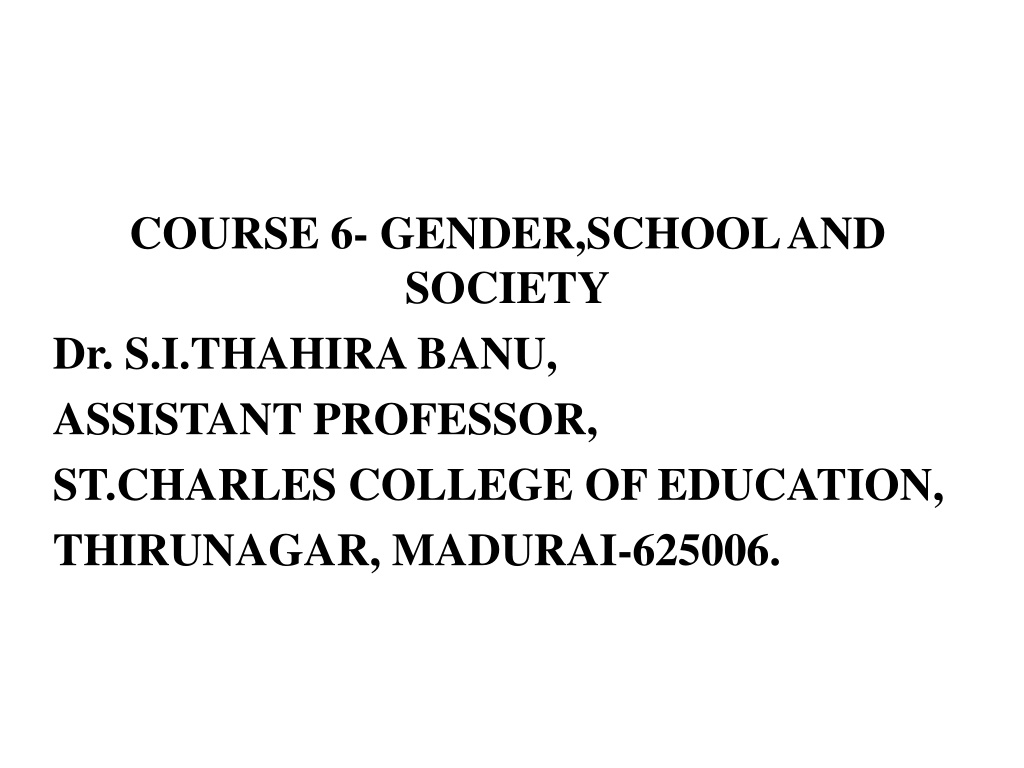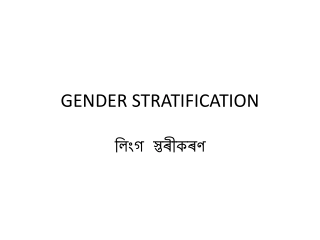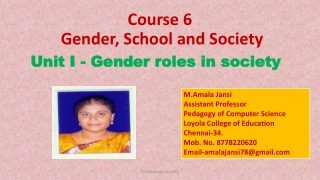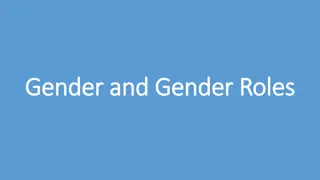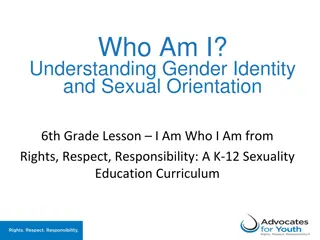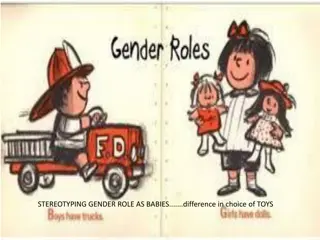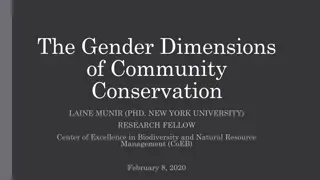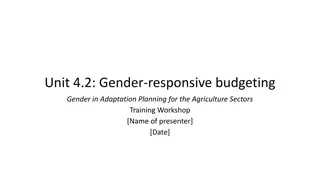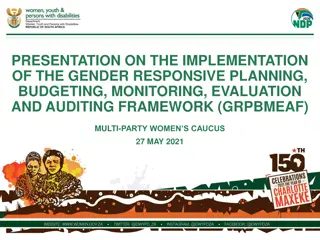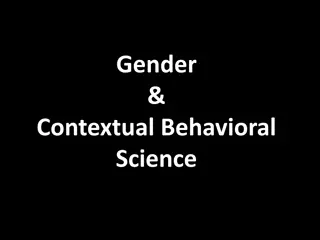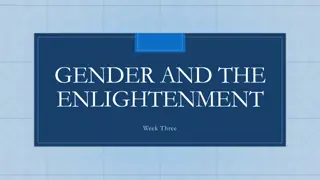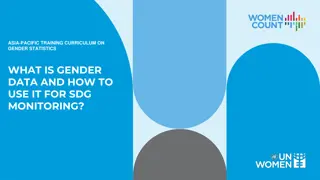Understanding Gender Roles in Society
Gender roles in society are socially constructed, with distinctions between gender and sex. Gender influences behavior, responsibilities, and societal expectations. Factors like family, caste, class, religion, culture, media, and laws play a significant role in shaping these roles. It's crucial to comprehend the meaning of gender, its definitions, and how it differs from biological sex to address and work towards gender equality and eliminate gender inequalities.
Download Presentation

Please find below an Image/Link to download the presentation.
The content on the website is provided AS IS for your information and personal use only. It may not be sold, licensed, or shared on other websites without obtaining consent from the author. Download presentation by click this link. If you encounter any issues during the download, it is possible that the publisher has removed the file from their server.
E N D
Presentation Transcript
COURSE 6- GENDER,SCHOOL AND SOCIETY Dr. S.I.THAHIRABANU, ASSISTANT PROFESSOR, ST.CHARLES COLLEGE OF EDUCATION, THIRUNAGAR, MADURAI-625006.
COURSE-6, GENDER, SCHOOL AND SOCIETY UNIT I: GENDER ROLES IN SOCIETY The concept of gender roles in society. The difference between gender and sex. The role of family, caste, class, religion, culture, the media and the popular culture, law and the state in the society. The reasons for gender inequalities.
GENDER: MEANINGAND DEFINITION Gender is a socially constructed term which has specified nature and meaning. It is manifestation towards the socio-cultural framework of man and woman in society which assign those duties, responsibilities and various social roles. A working definition in use by the World Health Organization for its work is that "Gender' refers to the socially constructed roles, behaviours, activities, and attributes that a given society considers appropriate for men and women" and that "'masculine' and 'feminine are gender categories.
Distinctions between Gender and sex Gender is socially constructed have specific roles, responsibilities and behavior patterns. Gender is culture specific It varies within and between in society (i.e. as per regulations of social institutions) o Sex is biological; it refers to noticeable differences in reproductive organs. o Sex is natural, constant and Universal. o Sex cannot be changed.
GENDER ROLES IN SOCIETY: Family, Caste, Class, Religion, Culture, The Media and The popular culture, law and the state. Gender refers to the socially learned attitudes and behaviours associated with being male or female. A role is the behaviour expected of someone who holds a particular status. The key word here is expected.
Family The child s first influence in regards to gender roles is the family. From birth to five years of age, most children are almost constantly surrounded by family. A child s first exposure to gender differences is learned through interaction with his or her parents. Most parents dress their infants in gender-specific clothing and give them toys according to gender stereotypes. Gender stereotypes are especially evident in the distribution of gender specific toys to children.
Gender and Caste Caste has undergone significant change since independence, but it still involves hundreds of millions of people. In its preamble, India's constitution forbids discrimination on However, caste ranking interaction have occurred for centuries and will continue to do so well into the foreseeable future, more in the countryside than in urban settings and more in the realms of kinship and marriage than in less personal interactions. negative basis and public caste. the of caste-based
Religion The main religions of the world all contain certain ideas about the appropriate roles for men and women traditionally, this has placed women in the home and men in the outside world. This holds true even nowadays, where much change is occurring in societies with increasing female labour market participation and changes in attitudes accompanying this. in society, and
Culture Culture refers to the beliefs and practices of another society, particularly where these are seen as closely linked with tradition or religion. Culture is part of the fabric of every society, including our own. It shapes the way things understanding of why this should be so. According to the World Conference on Cultural Policies (Mexico, 1982). Gender is related to culture as expectations about attributes and behaviours appropriate to women or men and about relations between women and men and in other words, gender are shaped by culture. are done and our
Social media Gender roles and stereotypes have slowly started to change in society within the past few decades. These changes occur mostly in communication, but more specifically during social interactions. The ways people communicate and socialize have also started advancement in technology. One of the biggest reasons for this change is due to social media. Social media helps create more equality, because every individual is able to express him or herself however they like. Every individual also has the right to express their opinion, even though some might disagree it still gives each gender an equal amount of power to be heard. to change alongside
MASS MEDIA Gender roles are prevalent in media, often portraying women as nurturing, gentle, cooperative, concerned with appearance, and sensitive to others; while men are viewed as logical, competitive, independent, assertive, financial providers, skilled in business and dominant over women. Women in media tend to be represented more negatively than men. While men are perceived as hard workers, amusing, directive, and physically aggressive, women are displayed as likeable, warm, submissive, passive, and weak. Women are also more likely than men to display empathic behaviours such as affection, sharing, giving, Advertising about computers typically depicted men and boys as competent users, engaged in active or professional roles, while women and girls were passive observers or merely posed net to the computer while looking pretty or provocative. Occupational status among men and women in media is clearly unequal. and concern for others.
Popular culture Popular culture might also be defined as a place for creating new forms of expression as well as a vehicle for critique. In particular, mainstream popular culture and media offer a space where new meanings are made through tactics such as culture jamming. jamming refers to the rewriting or reimagining of media such as advertisements in a way that subverts or overturns taken-for-granted ideas. Culture corporate logos or
Law and the State Access to justice is important for gender equality because it enables equitable enjoyment of a whole range of rights and resources. Law and justice institutions play a key role in the distribution of rights and resources among women and men across all sectors. They underpin the forms and functions of other institutions and reflect and shape development outcomes. Access to justice therefore is not just a right by itself, it is also a means to ensure equitable outcomes. Article 15 of the Constitution provides for prohibition of discrimination on grounds of sex also apart from other grounds such as religion, race, caste or place of birth. Article 15(3) authorizes the Sate to make any special provision for women and children.
UNIT SOCIALIZATION PROCESS The concept socialization practices. The role of school, peers, teachers, curriculum and textbooks in inequalities The knowledge regarding equality and its relationship to girls education The relationship and ideas of gender and gender inequality in text books and curriculum The sex roles stereotypes. II GENDER IDENTITY AND of gender identity and challenging gender
GENDER IDENTITY AND SOCIALIZATION PRACTICES Gender identity refers identification with a particular gender and gender role in society. The term woman has historically been used reference to the female body, though more recently this usage controversial by some feminists. Socialization is the process, through which the child becomes an individual respecting his or her environment laws, norms and customs. Gender socialization is a more focused form of socialization, it is how children of different sexes are socialized into their gender roles and taught what it means to be male or female to a personal interchangeably with has been viewed as
School and Organization School is another implement by which gender roles are transferred to children. This is mainly accomplished through peer influence. Therefore, school is also an area by which peers can influence other students towards more traditional gender roles. The materials used within the classroom also have an influence on the gender roles children learn. Organization of the reinforces the idea of men in positions of authority and women in subservient positions. This organization mirrors gender stereotypes that exist throughout society. school system itself
ROLE CURRICULUM CHALLENGING GENDER INEQUALITIES: When education is viewed transformative potential, as a social intervention that works towards realities, then it becomes the single most powerful process for redressing the inequalities of gender. Teachers' perceptions of male- and femaleness are crucial for their relations with pupils and can be an important factor in generating gender equity in schools. Gender stereotypes are also likely to be reinforced or weakened by text books and reading material provided in schools. OF SCHOOL, PEERS, TEXTBOOKS TEACHERS, AND IN in terms of its re-examining existing
Gender parity For a long time gender parity in education was dominating the discourse and the interventions. It is still commonly believed that gender inequalities in education will be resolved if equal access for boys and girls is provided and if gender disparities in enrolment figures and retention rates are eliminated. School School is another implement by which gender roles are transferred to children. This is mainly accomplished through peer influence.
Curriculum The Oxford Dictionary of English (2010) defines the curriculum as the subjects that are included in a course of study or taught in a school or college. It reflects the knowledge that society considers valuable and appropriate to be taught in schools. As society changes, the curriculum will also change, as well as the way in which it is viewed and what is considered valuable.
Textbooks Bias also surfaces in everyday curricula; students textbooks generally perpetuate male dominance. For these reasons, girls must have equal access to textbooks and gender representations must be changed. Teachers must also be trained to avoid contributing to the transmission of representations that convey inequality, whatever textbook is used.
UNIT III GENDER AND SCHOOL CURRICULUM The concept of gender roles. Gender roles in school curriculum The historical, political, economic and cultural structures regarding gender, sexuality, and intersecting systems of oppression. The role of women in addressing the gender issues.
The slogan Education For All (EFA) means enrolling and retaining all girls and boys in school. It is also about ensuring that girls and women of all ages develop their potential through education and are able to ensure their full and equal participation in building a better world. For many girls, gender inequality is a feature both of their lives and of their experience of education. Gender equality in teaching, is a central component of a good- quality education. So gender equality needs to be a central part of the development of the school curriculum and ways of teaching.
Transgender: education, employment and life skills Transgender, or Trans: means someone whose gender differs from the one they were given when they were born. Transgender people may identify as male or female, or they may feel that neither label fits them. Transition: In order to express transgender people change, from the gender they were given at birth. They may pronouns or style of dress. providing opportunities for their chosen may gender, transition, or change their names,
UNIT IV : VIOLENCE AND SAFETY OF GIRLSAND WOMEN The concept of Violence and Safety of girls and women The difference between Sexual abuse and violence. The Safety of girls and women at school, home and workplace. The role of education in preventing them. The reasons for gender inequalities The Meaning and objectification. concept of body
violence Violence against women is any violation of a woman's personhood, mental or physical integrity, or freedom of movement through individual acts and societal oppression. It includes all the ways our society objectifies and oppresses women. Violence against women sterilization abuse to prescription-drug abuse, pornography, stalking, battering, and rape. It includes the sexual and physical abuse of young girls and the abuse of elders. Every form of violence threatens all women and limits our ability to make choices about our lives. Sexual violence is particularly insidious because sexual acts are ordinarily and rightly a source of pleasure and communication. ranges from
VIOLENCE WOMEN IN INDIA Police records in India show a high incidence of crimes against women. The National Crime Records Bureau reported in 1998 that by 2010 growth in the rate of crimes against women would exceed the population growth rate. Acid Throwing Child marriage Domestic violence Dowry AGAINST GIRLS AND
SAFETY OF GIRLSAND WOMEN Self defence techniques are the first and foremost thing to which each and every woman must be aware of and get proper self-defense training for their safety. Generally most of the women are gifted with sixth sense which they must use whenever they become in some problem. Escape and run is also a good way to reduce some risks of women whenever they become in problem. Women must understand and feel their physical power and use accordingly. They should be careful while communicating with someone on internet in the cyberspace. Pepper spray can also be proved as a useful self-defense tool however it has a drawback that some people cannot be harmed through it even after full-face spray. They must have all the emergency numbers with them and whatsapp also if possible so that they can immediately tell to their family members and police. Women should be very conscious while driving the car and going to any trip.
MEANING OBJECTIFICATION Objectification is a notion central to feminist theory. It can be roughly defined as the seeing and/or treating a person, usually a woman, as an object. In this entry, the focus is primarily on sexual objectification, objectification occurring in the sexual realm. Violence in India is endemic and widespread predominantly against women. Most of the cases of abuse go unnoticed or unreported. Society and traditions, in some cases, sanction abuse by creating conditions for the victims to accept violence as a norm. AND CONCEPT OF BODY
UNIT V: MASS MEDIA AND GENDER 1. The concept of gender roles in mass media. 2. The gender stereotypes in mass media. 3. The gender identity roles.
GENDER ROLES IN MASS MEDIA The development of gender identity begins as early as two or three years of age. Parents, teachers, peers, and media are social influences on a growing individual. Adult treatment of infants plays a role in gender development when clothing is selected, when toys are purchased, and when television shows are viewed. As children grow, they gain a sense of being a male or female and associate various activities and objects with their gender.
GENDER MEDIA Gender roles are prevalent in media, often portraying women cooperative, concerned with appearance, and sensitive to others; while men are viewed as logical, competitive, independent, assertive, financial providers, skilled in business, and dominant over women. Women in media tend to be represented more negatively than men. STEREOTYPES IN MASS as nurturing, gentle,
GENDER IDENTITY ROLES Gender identity is the private experience of being male or female. Gender role is the public expression of gender, everything a person says or does that indicates a status as male or female. Gender role includes identification. Usually gender role correspond like two sides of the same coin, with a unity of gender identity/role. Gender identity develops through differentiation: interactions of biological, social, and cognitive-learning factors that occur over time. Differentiation means that a basically similar structure develops differently, depending upon the influence of other factors. social gender and identity legal and a process of
CONCLUSION Gender expectations. Males are presented as tough and emotionless while females are portrayed as influential and emotional. Although there are a few exceptions to stereotypical behaviour and image, the majority of characters fit the molds. It is pertinent that school counsellors and educators do everything in their power to deemphasize gender stereotypes presented research shows, media effects on young people play a dramatic role in self-esteem, emotional expression, career options, and self-acceptance. Stereotypes exist as generalizations within a culture whether they existed in media or society first. stereotypes coincide with society s in media. As
